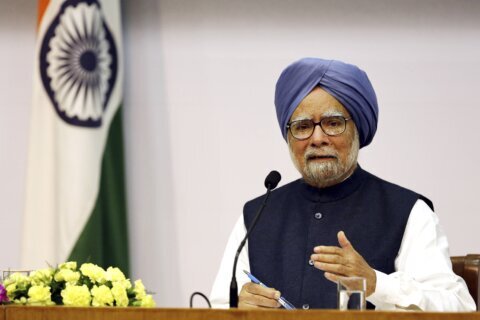The rise of the internet and social media makes it easier than ever to access information — and that includes information that’s false or misleading.
Add to that increasing political polarization, eroding trust in mainstream media and institutions, the rise of artificial intelligence products and a tendency to dismiss any information one doesn’t agree with, and many agree that the ability to critically evaluate information is a vital subject for schools.
“Media literacy is an essential life skill,” says Bobbie Eisenstock, a journalism professor at California State University–Northridge. “It’s probably more critical now than it ever has been because we live in such a complex digital society. Media technology is reshaping how we learn, play, interact, communicate and how we engage in everyday life.”
A 2016 Stanford University study, for example, showed that high school students had a hard time distinguishing between sponsored content and news articles or determining the potential bias of social media messages. A 2018 MIT study on the spread of false information on X, at the time known as Twitter, found that fake news stories were 70% more likely to be retweeted than true news stories.
The Center for Countering Digital Hate, a not-for-profit nongovernmental organization that exists “to protect human rights and civil liberties online,” surveyed more than 1,000 adults and more than 1,000 people between the ages of 13 and 17 in 2023 and found that belief in conspiracy theories was more common — 60% — among the latter group than others. That number rose to 69% among teens who are “heavy” consumers of social media.
The need for better media literacy education in schools is nearing a breaking point, some experts say, and health professionals have made public pleas saying as much. In May 2023, U.S. Surgeon General Admiral Vivek H. Murthy called on lawmakers to support media literacy in schools, while the American Psychological Association issued a health advisory recommending teenagers be trained in social media literacy before using the platforms.
[READ: ChatGPT in Classrooms: What to Know]
“A rising tide of voices is calling for us to protect our kids from the potential harms they can face in their digital worlds,” Erin McNeill, president and founder of Media Literacy Now, a nonprofit that works to expand the teaching of this subject nationwide, said in a press release. “Part of that solution has to be empowering our kids with the skills and knowledge they need to be safe and healthy in the many hours they spend on screens. We need to act now, and we have to — and will — find ways to reach as many schools and teachers and students as possible.”
But with only some schools teaching the subject and no national standards, it can be hard to know if your child is learning these skills. Here’s what to look for.
Who’s Teaching Media Literacy?
Media literacy education teaches students to think critically about media messages and to create their own media “thoughtfully and conscientiously,” according to Media Literacy Now.
High schools typically teach some form of media literacy in either a social studies or an English/language arts class, McNeill says. Others may teach it in a journalism or yearbook class. But she and others call for lessons to start earlier. Many students get a smartphone by middle school, giving them the ability to not only create their own content, but to see and share a wide variety of information.
A 2021 study of media literacy programs in Rhode Island found that only 1 in 3 middle schools were teaching the subject after passage of a law in 2017 requiring the state education department to “consider incorporating media literacy education” into the board of education’s program regulations. Only 1 in 5 elementary schools in the state teach children about the impact of advertising, the study found.
Kevin Anderson, a math and science teacher at Woodland Hills Academy in California, teaches a current events course as an elective that helps students build media literacy skills. For example, students identify reputable national and local news sources and analyze them as a class to decipher the “who, what, where, when, why and how,” he says.
His goal is to help his middle school students learn how to extract information from various texts and discern what legitimate news is.
“We basically try to increase their knowledge of the outside world,” he says.
Illinois was the first state to require media literacy education, although only in high school. Media Literacy Now publishes an annual Media Literacy Policy Report that tracks the status of media literacy education laws for K-12 schools in the U.S. According to the report:
— Ohio, New Jersey, Delaware and Florida require K-12 media literacy standards.
— New Jersey, Delaware and Texas require K-12 media literacy instruction.
— Illinois, Colorado, Massachusetts Nebraska and Connecticut require some limited form of media literacy instruction.
— Nebraska and Minnesota require standards in some grades and subject.
While the number of high schools tackling this subject is increasing, McNeill says, the percentage is hard to quantify because media literacy isn’t typically a stand-alone course.
“There’s no tracking for schools and districts,” says Michelle Ciulla Lipkin, executive director of the National Association of Media Literacy Education. “It’s frustrating because there are a lot of amazing practices, but it is in no way a national priority.”
What’s Being Taught?
The easiest way to begin to understand what your child’s school is doing is to ask, McNeill says. Find out what your child’s teacher or school thinks of media literacy and what is being taught.
Most recently, education about AI and how people can use it to manipulate images and text to seem real has become critical, experts say.
[READ: How to Talk to Tweens About Being Responsible on Social Media.]
“When you get to AI-generated content, it makes fact-checking even more necessary because AI-generated images, texts and narratives can be inaccurate, biased, plagiarized or entirely fabricated,” Eisenstock says. “It can even be created to intentionally spread disinformation. We’re talking about media literacy, and within media literacy is news literacy.”
Anderson says his students understand that not everything on the internet is real or true, but he still covers how to detect what’s fake versus what’s real. One example is what’s known as “deep fakes,” which are AI-created images and videos that look and sound like real humans and can be hard to distinguish. Anderson shows his students examples of these to see if they can decipher what is real and what is fake.
“I caution my students,” she says. “The information for my assignments in my regular math and science classes has to come from a book source.”
Parents should ask not only what schools are teaching, but what standards teachers are using and how officials know the lessons are effective, experts say,
Don’t despair if you don’t like the answers you receive, McNeil says, because curriculum improvement is a process. “From the grassroots, we can really make a lot of changes.”
What Does a Good Media Literacy Program Look Like?
A good media literacy program starts by teaching students how to ask good questions and become interrogators of information, experts say. By the end of middle school, students should be able to read laterally, meaning they can use the internet to check the veracity of news they see online.
According to the NAMLE, the core values of a solid media literacy education are teaching students “the ability to access, analyze, evaluate, create, and act using all forms of communication.”
“A media literate person can ask questions about who created a message and why,” Eisenstock says. “They can detect hooks that are used to construct the message and deconstruct its meaning, the values and viewpoints that are embedded in or omitted from the message and how different people might interpret it.”
The public often doesn’t understand professional journalism practices and ethical standards when it comes to checking facts and using digital tools to verify news, she says.
It’s crucial that students learn what quality journalism and proper media ethics look like, experts say. This helps people become better news consumers and not fall victim to information shared by people who don’t have journalistic training or hold themselves to any sort of ethical standards, says Stephany Zamora, executive producer of the documentary “Trustworthy,” which examines public perceptions of media, analyzing fake news and strengthening media literacy.
[Related:Q&A: Why Schools Should Focus on the Whole Child]
A good media literacy program teaches students to investigate whether there might be any bias in the media they’re consuming, she says. Students should learn to verify the journalistic integrity of that they’re consuming, she says.
“It’s kind of like if I went to a doctor. I wouldn’t go to a fake doctor,” she says. “I’d go to a doctor who’s trained to be a doctor, not someone who’s pretending to be a doctor. Right now, journalism is so important that it’s incumbent upon all of us to just be better consumers of information.”
McNeil says schools should also teach “digital citizenship skills” so students can not only understand the impact of what they are creating, but also learn to be “responsible, safe, and kind” online.
How to Help Boost Your Child’s Media Literacy
It’s at home where teenagers spend the majority of time consuming media, so good media literacy education requires parent involvement, Eisenstock says.
Parents need to understand how their children process information they see online, Lipkin says. “Are they asking questions and using evidence-based resources?”
Parents can do several things to help improve their child’s media literacy skills, Eisenstock says. First, she suggests parents develop family media guidelines to determine age-appropriate content. Then, when possible, use media together.
“When parents use media with their children, they know where they go and who and what they know, then they can talk to them about it,” she says. This can lead to valuable teaching moments and allow time for meaningful discussions about the content being presented to them.
Another important piece is managing screen time, which should involve parents adhering to any standards themselves. Modeling healthy behavior and media habits is one of the most important ways parents can improve their child’s media literacy skills, Eisenstock says.
“Children imitate what they see. They imitate their parents. So parents need to monitor their own screen habits and model respectful communication behavior online and offline.”
More from U.S. News
Is There a Lack of Diversity in Private Schools?
Understanding Charter Schools vs. Public Schools
Is a ‘Lab School’ Right for Your Child?
What Is Media Literacy? What Parents Need to Know originally appeared on usnews.com
Update 11/14/23: This story was published at an earlier date and has been updated with new information.







